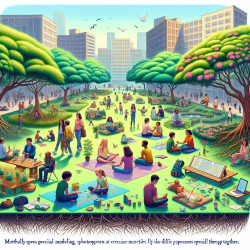As urbanization continues to reshape our cities, the connection between our environment and mental health becomes increasingly vital. A recent study titled Age- and Sex-Specific Association Between Vegetation Cover and Mental Health Disorders: Bayesian Spatial Study delves into this intricate relationship, revealing critical insights for mental health practitioners.
The study, conducted in Toronto, Canada, utilized remote sensing and Bayesian spatial hierarchical modeling to analyze the relationship between vegetation cover and mental health disorder cases. It found that reduced vegetation cover is significantly associated with poor mental health outcomes, particularly among young males and females.
Key Findings and Implications
Here are some of the study's key findings and how practitioners can use them to enhance their services:
- Young Males and Females (0-19 and 20-44 years): The study found significant negative associations between vegetation cover and mental health disorders in these age groups. This suggests that increased exposure to urban greenery can potentially improve mental health conditions in young people.
- Middle-Aged and Older Adults (45-64 and ≥65 years): No significant association was found between vegetation cover and mental health disorders in these age groups. Instead, socioeconomic factors were more influential.
Practical Steps for Implementation
Mental health practitioners can leverage these findings in several ways:
- Promote Outdoor Activities: Encourage clients, especially young people, to spend more time in green spaces. Activities like walking, jogging, or simply relaxing in parks can have restorative effects on mental health.
- Incorporate Nature into Therapy: Consider integrating nature-based therapies into your practice. Techniques such as forest therapy or nature walks can be beneficial for clients, particularly those in the 0-19 and 20-44 age groups.
- Advocate for Urban Greenery: Support community initiatives aimed at increasing urban greenery. Advocate for the preservation and expansion of parks and green spaces in urban areas.
- Tailored Interventions: Recognize that different age groups may respond differently to environmental factors. Tailor your therapeutic interventions to consider the unique needs and vulnerabilities of each age group.
Encouraging Further Research
The study underscores the need for continued research into the age- and sex-specific effects of vegetation on mental health. Practitioners are encouraged to stay informed about the latest research and consider participating in studies that explore these dynamics further.
Understanding the nuanced relationship between our environment and mental health can lead to more effective interventions and better outcomes for clients. By integrating these insights into your practice, you can help create a healthier, more resilient community.
To read the original research paper, please follow this link: Age- and Sex-Specific Association Between Vegetation Cover and Mental Health Disorders: Bayesian Spatial Study.










